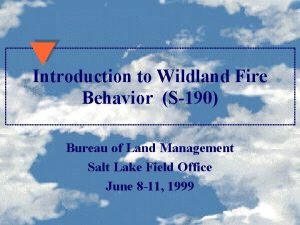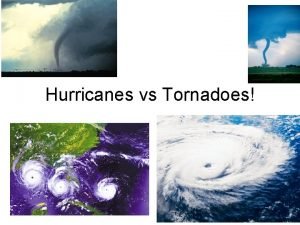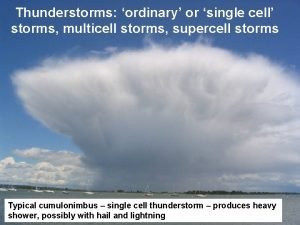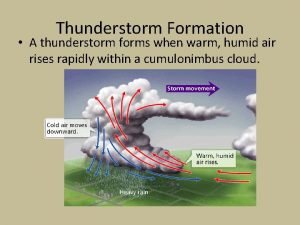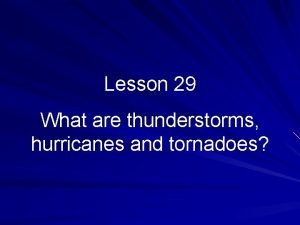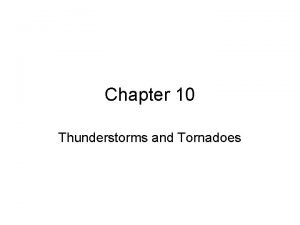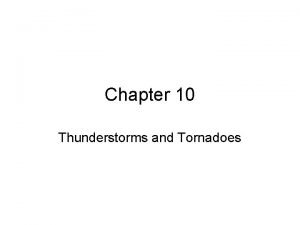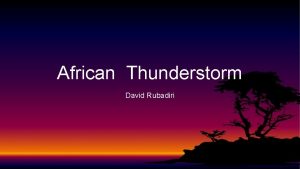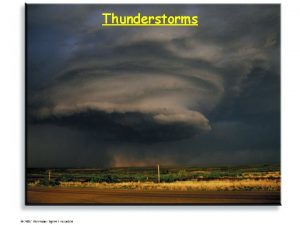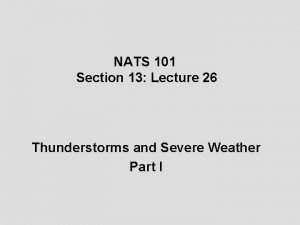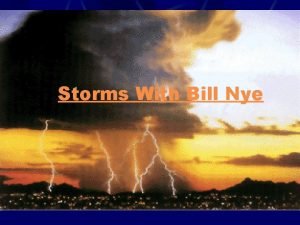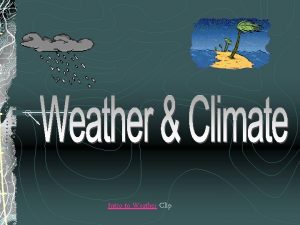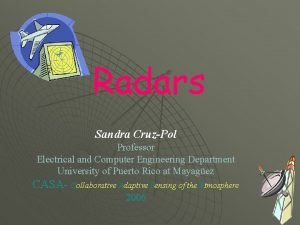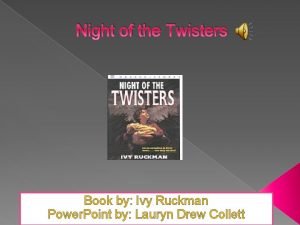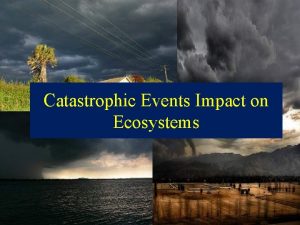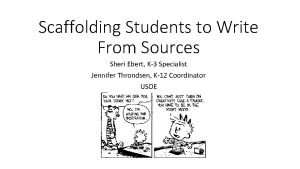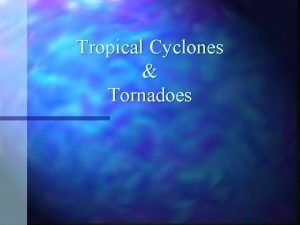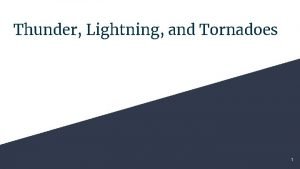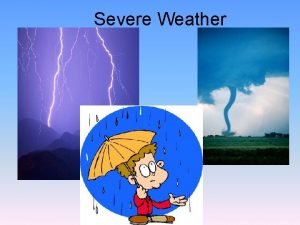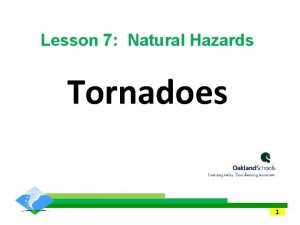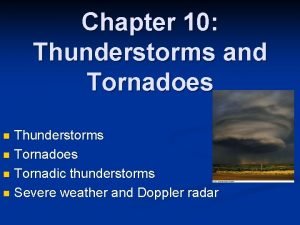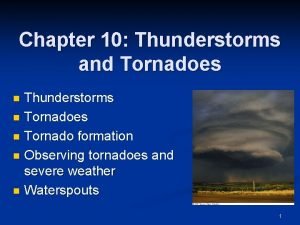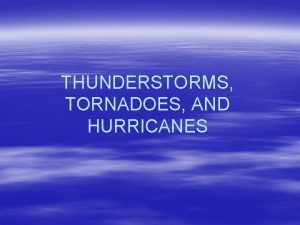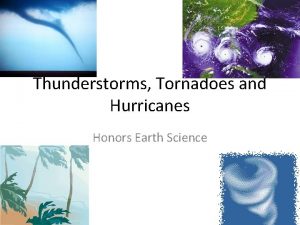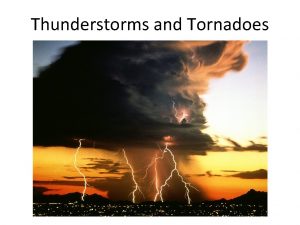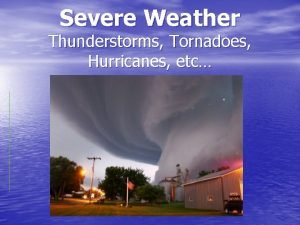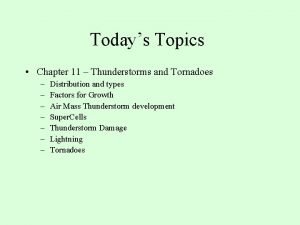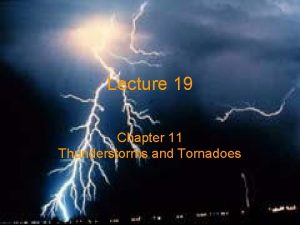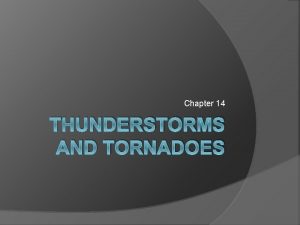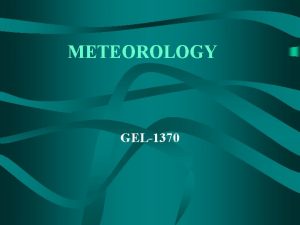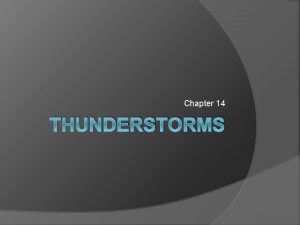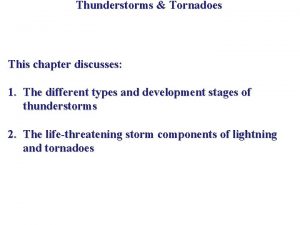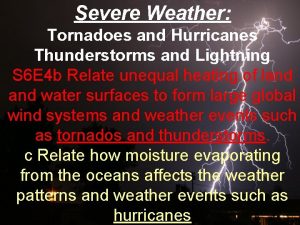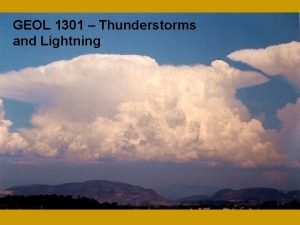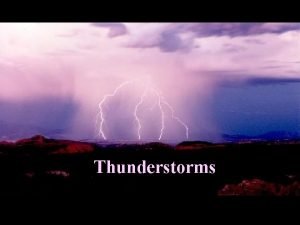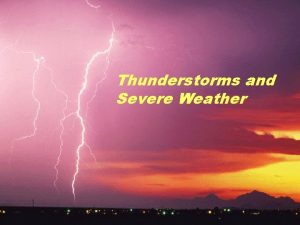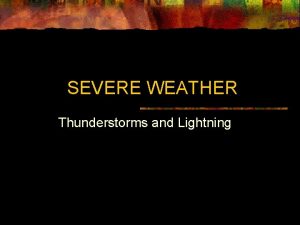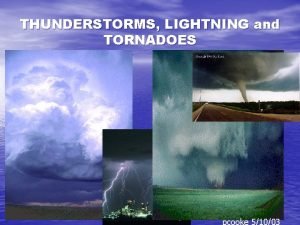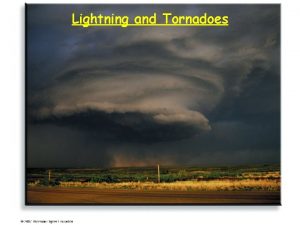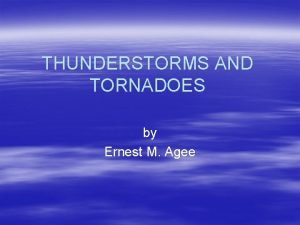Chapter 10 Thunderstorms and Tornadoes Thunderstorms n Tornadoes





























- Slides: 29

Chapter 10: Thunderstorms and Tornadoes Thunderstorms n Tornadoes n Tornadic thunderstorms n Severe weather and doppler radar n

Thunderstorms • Convective storms that form with rising air in a conditionally unstable environment • The trigger needed to start air moving upward may be surface heating; topographic lift; convergence zone (e. g. , sea breeze leading edge); frontal lift; divergence aloft

Ordinary Cell Thunderstorms cumulus stage n mature stage n dissipating stage n • Ordinary cell thunderstorms are sometimes called ‘air mass thunderstorms’, because they form in conditionally unstable air masses and are not necessarily associated with fronts or severe weather • Shortlived (<1 hr), less than 1 km wide, low wind shear, rarely produce strong wind or large hail • On 7/13/1999 in California, a strong downdraft from a mature thunderstorm dropped the air temperature from 97 F to a chilly 57 F in one hour!

Moisten environment latent heat warms the cloud layer; entrained dry air causes evaporative cooling and downdraft and gust front downdraft cuts off humid updraft; gust front is too far away to enhance updraft Fig. 10 -1, p. 265

Severe Thunderstorms and the Supercell Severe thunderstorm is defined as a thunderstorm with at least one of the following: large hail with a diameter > ¾ inch, surface wind gusts >50 knots (58 mi/hr), and/or produces a tornado multicell storms moderate wind shear

Supercell: Strong wind shear in speed and direction; Shallow inversion above warm and humid layer acts as a lid; Long-lasting (hours); Larger than 1 km in diameter; Single violently rotating updraft; Produces tornado, large hail, strong gusts Fig. 10 -5, p. 268

Squall Lines and Mesoscale Convective Complexes n squall line: multicell storms as a line of thunderstorms extending for many kilometers (up to 1000 km) pre-frontal squall line n mesoscale convective complex: multicell storms as a large circular cluster of storms; tend to form in summer in regions where the upper-level winds are weak; large size (100, 000 square km)

Dryline Thunderstorms n dryline • These storms occur frequently in the southern Great Plains of the US.

Gust Fronts, Microbursts and Derechoes n gust front: leading edge of cold air originating inside a thunderstorm n n n shelf cloud and roll cloud outflow boundary: merging several gust fronts downbursts (intense downdraft) and microbursts (< 4 km; caused aircraft crash) n Derecho (day-ray-sho): straight-line (not associated with rotation) strong wind extending for 100’s km produced by strong downdrafts; producing large hail and sometimes tornado

Fig. 10 -11, p. 271

Microbursts present a severe hazard to aircraft, especially during takeoff and landing. Several airports have installed microburst detection instruments. Fig. 10 -13, p. 272

A squall line thunderstorms appear in the shape of a bow (or bow echo) on a radar screen and produce a straight-line wind (derecho) Fig. 10 -16, p. 273

Floods and Flash Floods n flash floods: floods that rise rapidly with little or no advance warning 1976 Big Thompson flash flood (12 inch rain in 4 hours) The Great Flood of 1993 over the upper midwest

Distribution of Thunderstorms n n combination of warmth and moisture geographical placement Great Plains are more favorable for hails partly because evaporation of hail surface water cools the dry air

Lightning and Thunder n Lightning: a discharge of electricity, a giant spark, which usually occurs in mature thunderstorms (and may also occur in snowstorms and dust storms) majority of lightning strokes within clouds with only 20% between clouds and surface a lightning stroke can heat the air through it travels to 30, 000 C, 5 times hotter than the Sun’s surface n Thunder: The extreme heating causes the air to expand explosively, thus initiating a shock wave that becomes a booming sound wave n Do you see the lightning or hear the thunder first?

Electrification of Clouds For normal fair weather, the atmosphere is usually characterized by a negatively charged surface and a positively charged upper atmosphere electrical charges in clouds n relationships of updrafts and downdrafts to electrical charges n There is a net transfer of positive ions (charged molecules) from the warmer (and larger) hailstone to the colder (and smaller) ice crystal or supercooled droplets which are lifted to the upper layer of clouds

The Lightning Stroke cloud-to-ground lightning n stepped leader n return stroke n dart leader n -subsequent leader

Types of Lightning n n forked lightning ribbon lightning: hanging from clouds due to winds n dry lightning: cause forest fire n heat lightning: seen but not heard n St. Elmo’s fire: a corona discharge or sparks, can cause the top of a ship’s mast to glow; also seen over power lines and aircraft wings

Lightning Detection and Suppression n lightning direction-finder Detecting the radio waves produced by lightning

Where do you stay under thunderstorm? • Not under trees; • Avoid elevated places; • Keep your head as low as possible but not touch ground • Inside a building; • Inside a car Figure 2, p. 282

Tornado Life Cycles n tornado or twister: typically 100 -600 m, may >1 mi, usually at 20 -40 knots n funnel cloud: not reach the ground dust-whirl stage n mature stage n decay stage n tornado families: n different tornados spawned by the same thunderstorm n tornado outbreaks: 6 or more tornados over a particular region

Tornado Occurrence n n n tornado alley time of day: most frequent at 4 -6 pm LT times of year Annual number per state; Annual number per 100 mi by 100 mi

Tornado Winds n n multi-vortex tornadoes suction vortices

Seeking Shelter tornado watch: likely to form n tornado warning: spotted visually or by radar n • It’s always a good idea to know what to do if a tornado watch or warning is issued for your area. • Take shelter in the basement or small room in the middle of the house at a lower level and cover your head • Lie flat on the ground in a ditch • Don’t stay under a highway overpass • Don’t stay near window or wall

The Fujita Scale n tornado classification based on damage • The “F-scale” was named after Prof. Ted Fujita. • Wind damage is proportional to the square of wind speed

Tornadic Thunderstorms Supercell Tornadoes mesocyclones n bounded weak echo region n hook echo n rotating clouds n wall cloud n • A rotating wall cloud is an unforgettable sight - just ask a successful storm chaser.

Fig. 10 -35, p. 290

Nonsupercell Tornadoes n Gustnadoes: along a gust front n Landspouts: weak and short-lived, from congestus n cold air funnels: cold air aloft

Severe Weather and Doppler Radar Doppler shift n tornado vortex signature n rapidly changing wind direction n Doppler lidar use light beam, higher resolution NEXRAD n waterspout n
 Tornado and hurricane venn diagram
Tornado and hurricane venn diagram Contrast signal words
Contrast signal words Three types of general winds s190
Three types of general winds s190 Hurricane vs tornado
Hurricane vs tornado Single cell thunderstorms
Single cell thunderstorms Thunderstorms form when warm, humid air rises in a(n)
Thunderstorms form when warm, humid air rises in a(n) What cloud types would indicate convective turbulence?
What cloud types would indicate convective turbulence? What are thunderstorms
What are thunderstorms Cumulus stage of a thunderstorm
Cumulus stage of a thunderstorm Multicell thunderstorms
Multicell thunderstorms An african thunderstorm full poem
An african thunderstorm full poem Squall line
Squall line Downdraft
Downdraft Bill nye severe weather
Bill nye severe weather Brainpop1
Brainpop1 Sandra cruz denton tx
Sandra cruz denton tx Night of the twister book
Night of the twister book Tornado impact on ecosystem
Tornado impact on ecosystem Sheri ebert
Sheri ebert Tropical cyclone tornadoes
Tropical cyclone tornadoes What is tornado
What is tornado Tornadoes are most frequent from _____.
Tornadoes are most frequent from _____. Map of tornado alley
Map of tornado alley Effects of tornadoes
Effects of tornadoes Chapter 7 ionic and metallic bonding chapter answer key
Chapter 7 ionic and metallic bonding chapter answer key Chapter 7 ionic and metallic bonding answer key
Chapter 7 ionic and metallic bonding answer key Properties of ionic bonds
Properties of ionic bonds 7 ionic and metallic bonding practice problems
7 ionic and metallic bonding practice problems Chapter 9 chemical names and formulas
Chapter 9 chemical names and formulas Red tent summary
Red tent summary


